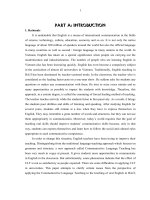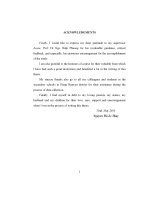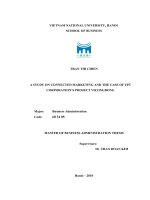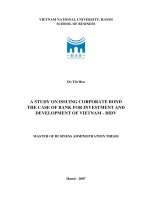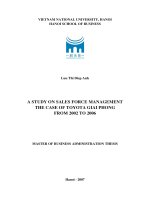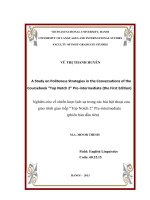A study on teaching grammar with the use of “flip teaching” to childten at popodoo english center
Bạn đang xem bản rút gọn của tài liệu. Xem và tải ngay bản đầy đủ của tài liệu tại đây (1.14 MB, 58 trang )
VIETNAM NATIONAL UNIVERSITY, HANOI
UNIVERSITY OF LANGUAGES AND INTERNATIONAL STUDIES
FACULTY OF POST-GRADUATE STUDIES
---------------------
LÊ THỊ THU PHƢƠNG
A STUDY ON TEACHING GRAMMAR WITH THE USE
OF “FLIP TEACHING” TO CHILDTEN AT
POPODOO ENGLISH CENTER
(Nghiên cứu dạy ngữ pháp áp dụng phƣơng pháp
Flip Teaching cho trẻ em tại Trung tâm Anh ngữ PoPoDoo)
M.A. MINOR PROGRAMME THESIS
Field: English Teaching Methodology
Code: 60140111
HANOI – 2017
VIETNAM NATIONAL UNIVERSITY, HANOI
UNIVERSITY OF LANGUAGES AND INTERNATIONAL STUDIES
FACULTY OF POST-GRADUATE STUDIES
---------------------
LÊ THỊ THU PHƢƠNG
A STUDY ON TEACHING GRAMMAR WITH THE USE
OF “FLIP TEACHING” TO CHILDTEN AT
POPODOO ENGLISH CENTER
(Nghiên cứu dạy ngữ pháp áp dụng phƣơng pháp
Flip Teaching cho trẻ em tại Trung tâm Anh ngữ PoPoDoo)
M.A. MINOR PROGRAMME THESIS
Field: English Teaching Methodology
Code: 60140111
Supervisor: Dr. Tô Thi Thu
Hƣơng
̣
HANOI - 2017
CERTIFICATE OF ORIGINALITY
I, the undersigned, hereby certify my authority of the study project report entitled:
“A study on teaching grammar with the use of “Flipped teaching” to
children at PoPoDoo English Center”
submitted in partially fulfillment of the requirements for the degree of MA in
English Language Teaching Methodology.
Except where the reference is indicated, no other person‘s work has been used
without due acknowledgement in the text of the thesis.
Hanoi, 2017
Lê Thi Thu
Phƣơng
̣
i
ACKNOWLEDGEMENTS
My thesis cannot be successfully completed without dedicated instructions
and assistance of several people as follows:
My first sincere thanks should be given to Dr. To Thi Thu Huong, my
instructor. She was unfailingly available for my questions and concerns, and always
ready with thoughtful suggestions and valuable insights. With her special expertise,
she provided me with extensive advice, encouragement, and careful guidance.
I wish to acknowledge the support of all students in Dolphin and Penguin
classes at PoPoDoo English Center for their continuous cooperation. With their
enthusiastic participation, I was able to carry out my study.
Lastly, I am greatful to all of my friends who continuously support me in
searching for ideas and necessary materials for the research.
ii
ABSTRACT
This action research is aimed to investigate the effects of flipped teaching method
on the students‘ grammatical competence and motivation for learning English
grammar.
Twenty four students aged from 8 to 10 at PoPoDoo English Center were chosen to
take part in the research. The initial observation before the research period showed
that the students‘ poor grammatical competence and low motivation in learning
grammar may be attributed to their exposure of uninteresting traditional way of
presenting grammar in the class. A plan of action using flipped teaching was
implemented to motivate and improve students‘ English grammar learning. By the
analysis of data from observation, a pretest and a post test, an interview, the
researcher could confirm the situation from the finding of the pre-data and collect
the results of the treatment by comparing it with the data collected by means of
post-data collection instruments. The analysis revealed that the use of flipped
teaching in English grammar teaching did improve not only their grammatical
competence (measured by the pre- and post tests) but also their attitudes towards
learning English grammar.
iii
TABLE OF CONTENTS
CERTIFICATE OF ORIGINALITY………………………………………………..............i
ACKNOWLEDGEMENTS ........................................................................................ii
ABSTRACT .............................................................................................................. iii
LIST OF ABBREVIATIONS .................................................................................... vi
LIST OF TABLES ....................................................................................................vii
LISTS OF FIGURES .............................................................................................. viii
PART A. INTRODUCTION .................................................................................... 1
1. Rationale .............................................................................................................. 1
2. Aims and research questions of the study ........................................................... 2
3. Significance of the study ..................................................................................... 2
4. Scope of the study ................................................................................................ 2
5. Overview of the thesis ........................................................................................ 3
PART B: DEVELOPMENT..................................................................................... 4
CHAPTER 1: LITERATURE REVIEW ................................................................ 4
1.1. Theoretical background .................................................................................... 4
1.1.1 Grammar and grammatical competence ...................................................... 4
1.1.2. Blended instruction..................................................................................... 5
1.1.2.1. Notions of blended instruction ............................................................ 5
1.1.2.2. Models of blended learning ............................................................... 6
1.1.3. Motivation .................................................................................................. 7
1.1.3.1. Definition of motivation ...................................................................... 7
1.1.3.2. Types of motivation ............................................................................. 8
1.1.3.3. Roles of motivation in teaching and learning a language .................... 8
1.1.4. Flipped teaching ......................................................................................... 9
1.1.4.1. Definition of flipped teaching .............................................................. 9
1.1.4.2. Model of flipped teaching .................................................................. 10
1.1.4.3. Traditional and flipped teaching ........................................................ 11
iv
1.2. Previous studies .............................................................................................. 12
1.3. Summary ......................................................................................................... 15
CHAPTER 2: METHODOLOGY ..................................................................... 16
2.1. Rationale for choosing action research ....................................................... 16
2. 2. Procedure .................................................................................................... 17
2. 3. Subjects of the study................................................................................... 18
2.4. Data collection instruments ......................................................................... 19
2.5. A Summary of data collection procedure .................................................... 20
CHAPTER 3: FINDINGS AND DISCUSSION ................................................... 22
3. 1. Data from observation ................................................................................... 22
3. 2. Data from tests ............................................................................................... 23
3.2.1. Data from pre-test ..................................................................................... 23
Table 1: Results on spoken test (pre-test) .......................................................... 26
3.2.2. Data from post-test ................................................................................... 26
3.3. Summary of findings ...................................................................................... 29
3.5. Implications for teaching ................................................................................ 29
PART C: CONCLUSION....................................................................................... 32
1. A summary......................................................................................................... 32
2. Limitations ......................................................................................................... 33
3. Suggestions for further study ......................................................................... 33
APPENDIX ................................................................................................................ I
v
LIST OF ABBREVIATIONS
EFL: English as a Foreign Language
ELT: English Language Teaching
SLA:Second Language Acquisition
vi
LIST OF TABLES
Table 1: Results on spoken test (pre-test)
Table 2: Results on the spoken test (post-test)
Table 3: Students‘ responses to the flipped teaching
vii
LISTS OF FIGURES
Figure 1: Blended learning/ Flipped teaching
Figure 2: Models of blended learning
Figure 3: Key elements of a flipped classroom
Figure 4: Differences between traditional and flipped teaching
Figure 5: Action research cycle
Figure 6: Number of students did not watch videos at home
Figure 7: Students‘ written pre-test results
Figure 8: The student‘s results in the post-test
Figure 9: Comparison of students‘ results in the pre and post-test
viii
PART A. INTRODUCTION
1. Rationale
In the 21st century with technical booming, it has been widely encouraged that the
integration of technology should be included into teaching. A great number of
teachers are gradually taking this innovative achievement to improve their teaching
methods and language teachers are no exception. This leads to the rise of a teaching
strategy named ―flipped teaching‖ where the students obtained their lessons online
in the form of a video or power point for prior preparation, then apply their
knowledge in classroom activities. In a flipped classroom, the time spent in class is
seen to take more significance than the videos recorded. Now, it gives room for
engaging activities, discussing, and working on the hard-to-understand information,
which converts the classroom an environment in which active learning takes place.
The classroom now becomes more student-centered. It is the opposite of the
traditional lecture-based class. Bergmann and Sams (2012) described activities in a
flipped class as ―which is traditionally done in class is now done at home, and that
which is traditionally done as homework is now completed in class‖.
This method appears to be working for the author‘s situation where the learners are
too young to learn English grammar in traditional lecture-based context.
Psychologically, they need something really interesting and attractive. To young
learners, grammar presentation should be neither too focused nor ignored. It should
be a minor part of a lesson. If grammar presentation takes a large amount of time in
the only-90-minute class, there is not much time for engaging students in practicing
the language. Furthermore, as aforementioned, because of the much exposure to
grammar, those students are more likely to be bored. Those will limit the success of
the lessons. Be fully aware of the existing problem, the author of this thesis, in her
capacity as an English teacher trying to solve the students‘ boredom in learning
English grammar, conducted a research entitled “A study on teaching grammar with
1
the use of flipped teaching to children at PoPoDoo English Center” to improve the
situation.
2. Aims and research questions of the study
The researcher would like to investigate the impacts of flipped teaching on students‘
English grammar learning and their attitudes towards the new method - Flipped
teaching - in her own environment. Thus, the study was conducted to address the
two following research questions:
1. To what extent does flipped teaching effect the students‘ English grammar
learning?
3. Significance of the study
Theoretically, this thesis is a small contribution to the theory of ELT on the impacts
of flipped teaching in grammar teaching in EFL classrooms.
Practically, this study is firstly expected to be an alternative way to expose the
students to more student-centered English lessons, and secondly to help enhance
students‘ grammar learning as well as their motivation in those classes.
4. Scope of the study
Firstly, in terms of English grammar learning, the scope of this research is confined
to the teaching-learning of the following grammatical items due to time constraint:
-
Singular and plural nouns
-
Present simple of Be: affirmative and negative
-
Prepositions of Location
-
How many? There is/ There are….
-
This/ That/ These/ Those
-
Possessive adjectives
2
-
Present simple with I, you, we, they
-
Present simple with he, she, it
In this study, English grammar learning is considered to be leading to the desired
English grammatical competence as measured by the pre- and post – tests.
Secondly, the study only focused on students aged from 8 to 10 (the majority of the
student population) at PoPoDoo English Centre in Hanoi.
5. Overview of the thesis
The thesis comprises of the following main parts:
PART A: INTRODUCTION - states an overview of rationale, aims of the study,
research questions, the scope, the significance and the overview of the study.
PART B: DEVELOPMENT
Chapter 1: Literature review - illustrates some related studies conducted by other
researchers as well as gaps in the field which inspire the writer to conduct her study.
This chapter also provides background knowledge of grammar and teaching
grammar, flip-teaching and motivation.
Chapter 2: Methodology - describes in detail the participants and all instruments
employed by the researcher as well as procedure to collect and analyze data.
Chapter 3: Findings and discussions - presents results of data analysis and
discussion of the findings.
PART C: CONCLUSION - Presents the conclusion of the study, some further
implications for teaching, along with the limitations and suggestions for further
study.
REFERENCES
APPENDICES
3
PART B: DEVELOPMENT
CHAPTER 1: LITERATURE REVIEW
In this chapter, the author lays the foundation for the research by presenting some
major terms in the theoretical background as well as related previous studies.
1.1. Theoretical background
1.1.1 Grammar and grammatical competence
According to Penny Ur (1991), at its simplest, grammar is generally defined as a set
of rules which describes the way words and groups of words can be arranged to
form correct sentences in a particular language. The term can also be applied to
smaller units such as phrases (a beautiful girl, for example, not a girl beautiful),
single words, and minimal components, namely affixes. Particularly, grammar can
be understood not only through structure but also meaning. In other words, a correct
grammatical structure must convey meaning within the rules and structure of the
target language.
On this basis, the notion of grammatical competence is raised. It is one of the four
areas of the communicative competence theory claimed by Canale and Swain (as
cited in Gao, 2001). The teaching and learning of grammar in a language aims to
develop learners‘ grammatical competence in that language. According to Orwig
(1999), those who have grammatical competence are able to recognize and produce
the distinctive grammatical structures of a language and to use it effectively in
communication. Hence, the learners should master their usage in real situations to
communicate messages. They should aims to acquire knowledge of, ability to use,
and forms of expression in the language which are grammatically correct (DíazRico & Weed, 2010).
4
1.1.2. Blended instruction
1.1.2.1. Notions of blended instruction
At its simplest, blended learning, also called hybrid learning, is the integration of
classroom face-to-face learning experiences with online learning experiences
(Garrison & Kanuka, 2004). George-Palilonis and Filak (2009) defined blended
learning as a combination of traditional and digital content delivery. They supported
the idea that traditional models usually fail to address all students‘ learning styles. If
properly-used technology work well in a blended classroom, it can reach more
students through various methods of instruction. Woodall (2012) claimed mingling
traditional methods with new method leads to a tool that provides modern training
and learning programs with two very powerful methods. Researchers have found
that blended learning significantly improved student attitudes. Many studies showed
blended learning instruction reduced students‘ negative emotions towards the
subjects. Another important finding is that blended learning increased students‘
beliefs of competency in the subject. Cascaval et al. (2008) came to a conclusion
that the blended classroom structure added significant value to education with
notable improvements in perceived performance and overall experience.
Additionally, Hwang (2011) agreed that pre-class reading or videos and electronic
discussions had a significantly positive impact on achievement.
Figure 1: Blended learning
(Retrieved from />
5
1.1.2.2. Models of blended learning
According to an article in the website there are four models of blended learning
including Rotation, Flex, A La Carte, and Enriched Virtual. The Rotation model
comprises of four sub-models: Station Rotation, Lab Rotation, Flipped Classroom,
and Individual Rotation.
1.Rotation model — a course that students rotate on a fixed schedule or at the
teacher‘s selection among learning modalities, at least one of which is online
learning. Some other alternative modalities may include small-group or full-class
instruction, group projects, individual tutoring, and pencil-and-paper assignments.
a. Station Rotation — a course where students experience the Rotation model
in a contained classroom or group of classrooms.
b. Lab Rotation – a course where learners rotate to a computer lab for the
online-learning station.
c. Flipped Classroom – a course where students participate in online learning
off-site in place of traditional homework and attend the class for face-to-face,
teacher-guided practice. The main delivery of content and instruction is
online.
d. Individual Rotation – a course where the teachers deliver individual
student schedules.
2. Flex model — Most of the curriculum is delivered via a digital platform and
teachers are available for face-to-face consultation and support.
3. A La Carte model — a course that learners take entirely online to accompany
what they are having at a brick-and-mortar school or learning center. The teachers
for the A La Carte course are the online ones.
4. Enriched Virtual model — a course in which students have required face-to-face
learning sessions with their teachers and then are free to complete their remaining
6
coursework remote from the face-to-face teacher. The Enriched Virtual model
differs from the Flipped Classroom because in Enriched Virtual programs, students
seldom meet face-to-face with their teachers every weekday. It differs from a fully
online course because face-to-face learning sessions are required.
Figure 2: Models of blended learning
(From />1.1.3. Motivation
1.1.3.1. Definition of motivation
It has been widely believed that motivation is necessary for most fields in life.
Without motivation, it is harder to make efforts to obtain the goals (Johnstone,
1999). Martin (2003) defined, ―Motivation is students‘ energy and drives to learn
and achieve. Motivation is learnable and changeable.‖ Additionally, Ellis
(1994:715) also agreed that motivation was the efforts which learners make for
learning a language because of ―their need or desire to learn it‖.
7
1.1.3.2. Types of motivation
Motivation can be categorized into intrinsic motivation and extrinsic motivation
(Ryan & Deci, 2000).
Intrinsic motivation can be understood as the inner eagerness to do and participate
in a certain activity since they find that activity enjoyable. With intrinsic
motivation, the student studies subject materials for the sake of learning. On the
other hand, extrinsic motivation comes from outside elements. Extrinsically
motivated students study for the sake of outside influences such as getting teacher
and peer praise, acquiring a good grade or some other types of reinforcement that a
teacher or peer might offer.
Both intrinsic and extrinsic motivations have been well-researched, and the
distinction between them has important influence on developing both mental and
educational practices. Most researchers and methodologists show that intrinsic
motivation is especially significant for encouraging success. It is advisable that the
educators should focus on enhancing learners‘ intrinsic motivation to learn.
(Cameron & Pierce, 1994)
1.1.3.3. Roles of motivation in teaching and learning a language
There are three main factors which influence the teaching-learning a language. They
are age, personality, and motivation. Cook (2000) emphasizes that among the three,
motivation is the most significant in second language acquisition (SLA) and
naturally, in language leaning.
In conclusion, the learning motivation is personal and comes from inside an
individual, but can be impacted by external factors. When teachers know how to
encourage students‘ motivation in their teaching, the students will become more
excited and more successful in their learning experience.
8
1.1.4. Flipped teaching
1.1.4.1. Definition of flipped teaching
Flipped teaching, also called ‗flipped classroom‘ or ‗inverted classroom‘ (Strayer,
2009), is described as a reversal of traditional teaching, in which students first get
access to the new material outside their class, usually in the form of lecture videos
or power point slides. The class hour is just spent for a number of follow-up
activities (Brame, 2013).
Figure 3: Key elements of a flipped classroom
(from />According to Lage, Platt, and Treglia (2000: 32), ―inverting the classroom means
that events which have traditionally taken place inside the classroom now take place
outside the classroom and vice versa. The use of learning technologies, particularly
multimedia, provide new opportunities for students to learn, opportunities that are
not possible with other media.‖
Baker, (2011:2) suggested a similar concept and he called the flipped classroom
―The basic concept I applied in that class was to move the rote transmission of
information that had been the content of my lectures out of the classroom (delivered
instead through network-delivered presentations) and to use the opened-up class
time for the students to work on application of the principles from that content
9
while I was there to see what they were doing, answer questions and make
suggestions‖.
To recap, flipped classrooms are a form of of blended learning, which refers to any
forms of education combining face-to-face instruction with online activities.
Flipped classroom seems ―pedagogically sound‖ because it ―serves the
principles of personalized-differentiated learning, student-centered instruction‖ in
which learners take more responsibility for their learning. It is personalized as
learners can learn at their own pace; student-centered because the class time can be
used as an environment where they join many engaging follow-up activities and
teachers takes the role as a facilitator. However, it is noted that flipped teaching is
not limited to watching videos at home and doing homework in the classroom
(Nicolosi, 2012).
1.1.4.2. Model of flipped teaching
Başal (2012) suggested that flipped teaching can be divided into two learning
environments: outside and inside. Both sides should be integrated into each other in
order to be effective.
The first step for teachers is Planning. Teachers should plan in detail what to do
inside and outside the class. The second step is selecting appropriate activities.
The activities should be various to address the needs of all learners. These may
provide rich learning opportunities for all students with different learning styles.
The third step, the teacher should think how to integrate outside and
inside
smoothly. This is particularly essential as flipped teaching is to support blended
learning. The last step is to use a Learning Management System (LMS), a software
platform that allows to present all the learning and teaching activities and materials
delivered over the Internet, to the students in an organized way.
10
1.1.4.3. Traditional and flipped teaching
Bergmann and Sams (2012) suggested several major differences between traditional
and flipped model.
In the traditional model, students usually come to the class with some confusion
about homework problems from the previous lesson. The teachers are typically the
central focus of a lesson and present new content for 30 to 45 minutes and spend the
rest of the class hours with independent practice.
In the flipped model, the time is totally restructured. Students need to ask questions about
the content that was delivered before the class, so these questions would be addressed
during the first few minutes of lessons. This allows students to clear up misunderstanding
before they come to practice session and more extensive follow-up activities.
Figure 4: Differences between traditional and flipped teaching
11
As a result, a teacher's interaction with students in a flipped classroom can be more
personalized and students are actively engaged in acquiring knowledge as they
directly take part in and evaluate their learning.
1.2. Previous studies
To lay the background for the thesis, several related previous - studies have been
reviewed and presented below.
Strayer, (2007) looked into the effects of the classroom, flipped on the learning
environment in a traditional and a flipped classroom with an intelligent tutoring
system. This research compared the flipped classroom and the traditional
lecture/homework structure in two different college level introductory statistics
classrooms. In the flipped classroom, an intelligent tutoring system (ITS) was used
to deliver the lecture content outside the classroom. In the lecture/homework
classroom, students attended lectures on course content that included PowerPoint
slides, and then they practiced with the course concepts by completing homework
from their books outside of class. Students were given the College and University
Classroom Environment Inventory (CUCEI) to measure both their learning
environment preferences and their learning environment experiences. In addition,
data were collected via field notes, classroom transcripts, student interviews, student
focus groups, researcher journal entries, and student reflections. The quantitative
data were analyzed using t-tests and MANOVA, and the qualitative data were
analyzed using grounded theory methods. The findings of this research showed that
classroom - flipped students were less satisfied with how the structure of the
classroom oriented them to the learning tasks during the course. The variety of
learning activities in the flipped classroom contributed to unsettledness among
students that traditional classroom students did not experience.
George-Palilonis and Likak (2009) found a gap between students who understood
the materials better in a flipped classroom as opposed to those who did not, as well
as a split between students who felt confident going into the test after learning in a
12
flipped classroom and those who did not. Some students mentioned that the
increased group work helped to enhance their motivation, understanding, and
interest in the topics. They also liked the class activities because it allowed them to
directly receive their teacher‘s assistance during practice time, a benefit of the
flipped style over traditional one. This study found out that the flipped classroom
instruction had a generally positive effect on students‘ attitudes and perceptions,
specifically relating to the classwork.
Başal (2012) carried out a research entitled ―The Use of Flipped Classroom in
Foreign Language Teaching‖ in Foreign Languages Education Department of
Yıldız Technical University in ―Advanced Reading and Writing I‖ course. He
utilized Wallwisher, a web 2.0 tool to study students‘ opinions on the use of flipped
learning model. The findings showed that the attitudes of a majority of the students
towards the use of a flipped learning model were positive. He emphasized that
flipped learning is not merely using the lecture videos outside the classroom.
Choosing the appropriate engaging activities in the classroom time is also
important. To be concluded, some suggestions to flip classrooms are demonstrated:
- Pay attention to students‘ learning styles and then elect suitable activities based on
the learning styles of the students.
- Learn to use basic technological tools and integrate the appropriate web 2.0 tools.
- Prepare carefully what to the inside and outside the classroom and use an LMS
(Learning management system) to integrate the two sides.
- Use a wide range of activities to engage all of the students.
Nicolosi (2012) investigated the use of flipped classroom method in grammar
lessons as an alternate way of lecturing grammar in a language class. He claimed
that the flipped classroom method helped students to switch from passive to active
lecturing mode. He step by step worked out the benefits as well as the drawbacks of
this method. Finally, he drew a conclusion that deciding to flip parts of the lesson
13
will not automatically make it a better lesson. It is important to be intentional
about when to flip and clear about what the benefits will be for students.
Dill (2012) conducted a two-week action research on the effects of flipped teaching
on student achievement and engagement in a 7th Grade French I classroom
including homework completion, behavioral interventions, grammar proficiency
and writing proficiency. There are two groups of students including control group
and experimental group, named ―Group B‖ and ―Group F‖. The study compared
and contrasted the impacts of flipped teaching in one group before and after
intervention of flipped teaching as well as results between two groups. Forty-three
students were involved in this study. Results of student surveys demonstrated that
students were able to receive instruction outside of the school via Internet in order
to participate in lessons. Students‘ engagement and homework completion would be
improved, while behavioral interventions would decrease in the classroom. The
increase in students‘ proficiency would also be strongly supported by significant
increases in average class grades in grammar and writing. Regardless of
shortcomings, the students performed better on assessments, and did all the
homework and maintained good behavior while the lessons were flipped. The
findings strongly encourage the author‘s belief that flipped teaching is worth trying
by all 21st century teachers.
Mousel (2013) investigated the effectiveness of flipping in a High School
Mathematics Classroom. Twenty two high school juniors enrolled in an
International Baccalaureate Standard Level math class took part in the project.
Students received instruction under the Flipped Classroom model for lessons in a
unit on trigonometry. After the lessons, students completed a ten-item survey
questionnaire consisting of both Likert-scale and open-ended questions regarding
student perceptions, attitudes, and beliefs of competency. The research gained
positive results, which can be shown in the students‘ motivation in Maths and their
awareness of the helps of flipped teaching in learning Maths.
14
Most students did not notice any big challenges. Some mentioned difficulties with
the hands-on approach due to learning styles, distractions from group work, boring
videos, and general difficulty in adjusting to a new style of learning. On the
contrary, 13 students mentioned group work, hands-on activities, and/or classroom
projects as the most enjoyable aspect. They explained that the flipped teaching time
allowed more freedom, experience, and fun.
1.3. Summary
In summary, this chapter has provided a review that spans English-language sources
covering research from around the world to be relevant to flipped teaching in the
language classroom. As presented, most research above illustrate the effects of
flipped teaching in teaching grammar, which is really needed for the researcher‘s
situation. However, as far as the research of this paper is concerned, all of the
mentioned research addressed students at higher education levels, not young
learners. Moreover, in different environments, this method may work differently in
the contribution to the effectiveness of teaching grammar. That‘s why the researcher
desires to conduct this research to examine its effects in her own environment and
improve the existing the situation.
For the success of the research, a number of factors should be put into
consideration. First, the educators should bear in mind that flipped teaching is more
than delivering videos and materials before the class. They should be well-prepared
prior to delivery and be interesting enough to attract students‘ attention. Second, the
teachers ought to pay attention to various activities in the class to enhance students‘
grammatical competence.
15
